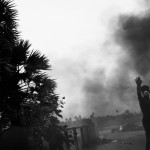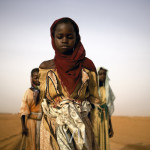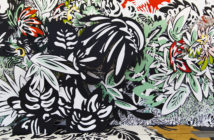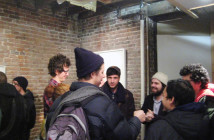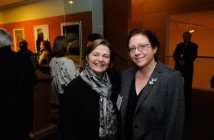Although World War II ended 65 years ago and its slipstream, the Cold War, began to grind to a halt around 1985, the world remains an unquiet place. Since the Cold War, we have witnessed bloody conflicts in Bosnia, the Congo, and Palestine (to name a few); the destruction of the Twin Towers and the wars in Afghanistan and Iraq in response; and a continuing litany of catastrophes both natural and manmade -- Chernobyl, AIDS, the 2004 Asian tsunami, widespread poverty. The photographs presented in “Questions Without Answers” -- works by photojournalists from the noted VII Photo Agency -- document these and similar events of the past 25 years. These superb works -- a mix of color and black-and-white photographs -- are compelling, and will stay with the viewer long after leaving the gallery.
The photographs are presented in four groups. Endless War covers the two most widely visible events of the Post-Cold War period -- the fall of the Berlin Wall and the destruction of the World Trade Center -- as well as the ensuing Afghanistan and Iraq Wars, while Never Again... addresses regional conflicts elsewhere in the world: the Balkans, Chechnya, Africa, the Middle East.Displays of Power focuses on images of the powerful and the powerless. The fourth group, Lives in the Balance, examines the effect of non-conflict disasters on those trapped within them.
The curator has chosen an unconventional installation format: the images are all unframed and are hung at varying heights within their groups. The intent (largely successful) is to jar the viewer into viewing the images with a less jaded, more thoughtful eye; the nonlinear presentation makes you stop, look, and look again, rather than wandering absently down an endless line of photographs. The lack of frames draws the viewer into the image and suggests that it is part of a scene that extends well beyond the image in all directions. A frame would act as a boundary, creating an emotional distance between viewer and image and giving the sense that it is primarily an art object. Each photograph is identified only by a small, simple gallery tag; small books available in the gallery provide additional commentary.
The VII photojournalists whose works appear here are not trying to provide so-called “balanced” journalism, in which all points of view are presented without regard to merit. (Since the onset of “embedding” reporters with military units, balanced journalism during a conflict has become a difficult objective; compare coverage of the Iraq War with the gut-wrenching reporting that came out of Vietnam.) Founded in 2001, with the goal of "rais(ing) awareness of today’s most pressing humanitarian challenges," VII Photo Agency picked up where Magnum Photos arguably left off in the 1980's (who have since diversified their model to include fine art photographers that have a stylized editorial approach). The VII photographers are looking for truth on the ground, often in dangerous places: the things that go on in the dark corners, the hidden alleyways, the secret offices, the killing fields; they provoke the questions, start the discussions.
They also make real and immediate the details of world events that are distant from us. A photograph, for example, of Palestinian residents of the Jenin refugee camp atop a huge mound of rubble, searching for the missing, brings home the extent of destruction in a way that headlines and text cannot. Another photograph shows an eerily defaced portrait of a Bosnian family -- the faces are scratched out and a long scar is gouged down each body -- that was found by the family when they returned to their home after occupying Serbs vacated it; the venom is visceral.
The order in which the curator has chosen to present the photographs provides (perhaps intentionally, perhaps not) some memorable counterpoints. In one, a grinning child soldier -- just a boy -- points a large weapon at the camera (Marcus Bleasdale, Congo, 2008), while in a photograph just around the corner, a girl of about the same age leaves an IDP camp, risking rape or even death, to search for firewood (Ron Haviv, Darfur, 2005); her face shows stoicism, resignment, and immense dignity. A second is blackly humorous: George Bush, standing with his hands hanging loosely at his sides in a “draw, podner” pose while flanked by Dick Cheney and Donald Rumsfeld (Christopher Morris, Texas, 2004), scowls sideways at three formally posed Muqtad al Sadr loyalists, two of whom carry handguns (Franco Pagetti, Baghdad, 2006).
This exhibition is particularly timely, given the earthquake that devastated Haiti only nine days before the show opened. How long will it take for the immediate impact of the quake to fade away; for the contributions to trickle off, leaving only the NGOs to help Haitians rebuild their homes and their lives? A month, two months? Most of us will long since have gone back to the details of our daily lives while Haiti struggles to survive. This is the mission of the independent photographers affiliated with the VII Photo Agency: to keep the larger questions before us, to remind us that we are part of the world, that all of these struggles are, sooner or later, our struggles. Their photographs are our memory; their dedication is our conscience.
- Joachim Ladefoged, Mullaittivu, Sri Lanka, January 5, 2005 – A young man searches for the dead in the fishing village of Mullaittivu, Sri Lanka. The village was one of the most devastated areas of Sri Lanka in the wake of the December 2004 tsunami that struck parts of Asia. After two decades of ethnic fighting between the Sinhalese majority and the separatist Tamils, soldiers on both sides united in helping the island’s tsunami refugees. But throughout the aid missions, tensions remained between the two groups.
- Ron Haviv, Darfur, Sudan, June 25, 2005 – Young girls leave a camp for internally displaced persons (IDPs) to gather firewood. For some, the work will take more than seven hours, lead them past government checkpoints, and leave them exposed to attacks. Many people express fear and wish there were amore secure way to gather wood, essential for cooking in the camp. Girls as young as eight have been raped, attacked, and killed trying to get wood.
- Alexandra Boulat, Mazar-e-Sharif, Afghanistan, September 29, 2004 – Women’s day in Mazar-e-Sharif’s Hazrat Ali shrine. Afghan women have recently gained the right to vote. In Kabul universities are becoming mixed and women can walk by themselves in the streets. However, Afghan society still remains among the worst in the world for gender equality, particularly as soon as one gets away from the capital city.
"Questions Without Answers: A Photographic Prism of World Events, 1985-2010" is on view through April 4, 2010 in the Tisch Gallery at the the Aidekman Arts Center on the Tufts University campus in Medford, MA.
All images are courtesy of the photographers and Tufts University Art Gallery.


